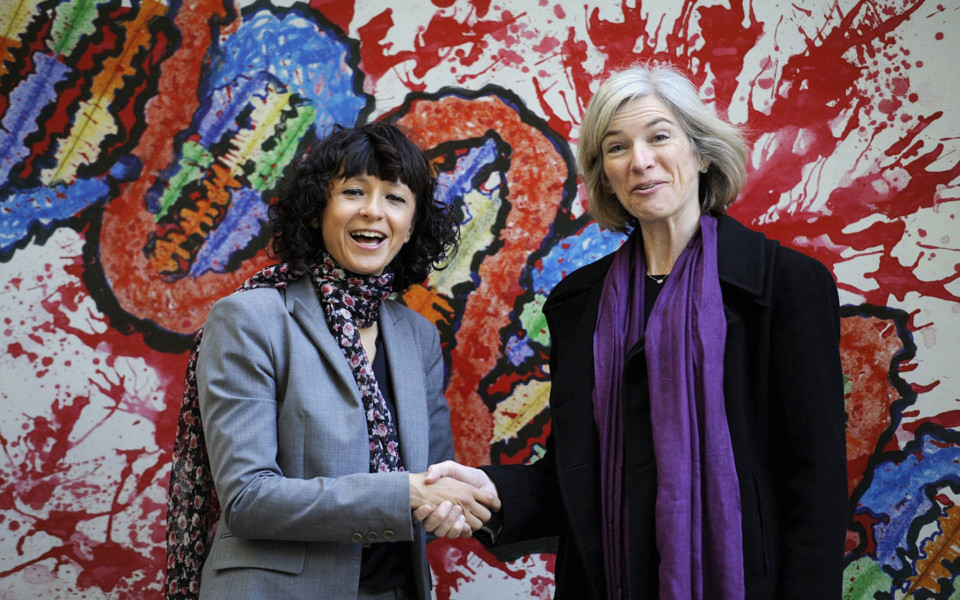Meet The Scientist Bringing Gene Editing To Life: An Interview With Jennifer Doudna
About 10 years ago, scientists at a yogurt laboratory in Denmark noticed a peculiar feature in a bacterial genome. They spotted repeating patterns of bases—the components of DNA sequences, denoted as A, T, G and C—that were the same backward and forward. Such genetic palindromes had been seen before and had already been given a name: clustered regularly interspaced short palindromic repeats, or CRISPR.
But the yogurt scientists noticed something strange. Sandwiched inside the CRISPR sequences were strings of bases that exactly matched DNA sequences from a virus that had infected their bacteria.
The appearance of viral genome sequences inside the bacteria could mean only one thing: The bacteria had mounted an attack against the virus and was now equipped to recognize such future invaders. The bacteria were doing what humans do, adapting their immune system to survive.
Across the globe, scientists dug into the discovery. Two of them—Jennifer Doudna, a microbiologist at the University of California, Berkeley, and Emmanuelle Charpentier, a microbiologist now at Berlin’s Max Planck Institute for Infection Biology—figured out how the adaptive immunity happened. In short, a protein called Cas9 cuts into the viral genome so that the bacteria can integrate a portion into its own DNA.
Doudna and Charpentier found that the CRISPR-Cas9 complex could be fairly easily co-opted to alter the genetics of other organisms. In other words, CRISPR-Cas9 is an entry point for genetic engineering. They published this finding in 2012. But this team wasn’t the only one trying to unravel CRISPR-Cas9 and figure out how to capitalize on nature’s genius. At the Broad Institute, bioengineer Feng Zhang was doing the same.
A major looming question at the time was whether CRISPR-Cas9 could be used to alter the DNA of eukaryotic cells; that is, cells with a confined nucleus and other distinct parts held inside a membrane. Plants are eukaryotes. So are humans. (Bacteria are not.) If CRISPR-Cas9 were to be used to edit human genes—say, for the purpose of curing a disease rooted in DNA—then finding a way to introduce the technique into eukaryotic cells could be crucial. And the university employing the scientists who succeeded, as well as the scientists, stood to gain both significant prestige and a large amount of money.
Scientists working with CRISPR-Cas9 knew their research could lead to unprecedented commercial developments, but securing ownership of the discovery, and thereby profiting from its commercialization, depended on filing a patent. At the time this work was unfolding, the United States followed a “first to invent” patent system; the individual who first conceived of the idea was entitled to own it. In 2013, under the Leahy-Smith America Invents Act, the U.S. switched to a “first to file” system, followed by nearly every other country, granting ownership to whoever filed the patent first.
Doudna filed a patent for the technology using CRISPR-Cas9 to alter DNA in May 2012, before the patent system changed to first to file. That December, Zhang filed a more specific patent claim for a technique using CRISPR-Cas9 specifically for altering eukaryotic cells. Zhang’s application included a request for an expedited review, which requires an extra fee. Zhang was awarded ownership of this intellectual property in 2014 (patent number 8,697,359), and Berkeley filed a “patent interference,” a request for the U.S. Patent and Trademark Office to investigate the application for possible overlap with theirs, which was filed earlier.
The interference filing set off a long battle that spurred countless news reports, bitter arguments and professional attacks. On Wednesday, more than a year after the fight began, the patent office gave its ruling: the Broad Institute’s patent stands. Doudna’s May 2012 patent application, which covers use of the CRISPR-Cas9 technology in other types of cells, is still pending.
Newsweek spoke with Doudna about the ruling, the CRISPR-Cas9 technology and what’s next for her…


